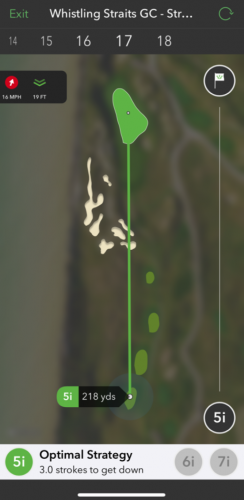Whistling Straits Strategy Analysed - How The Ryder Cup Will be Won
We analyse the final five holes at Whistling Straits with the help of Golf Monthly's official data partner Arccos


We analyse the final five holes at Whistling Straits with the help of Golf Monthly's official data partner Arccos
Arccos, the pioneer of big data and artificial intelligence for golf, has highlighted several strategies that can offer the best results over the closing holes on this week’s Ryder Cup course, based on the experience of Arccos Caddie users.
Taking into account elevation and wind speed, the Arccos Caddie platform has mapped out a number of ways that the 24 players could tackle holes 14-18 - invariably where key matches are going to be won or lost at Whistling Straits.
Whistling Straits Strategy Analysed - How The Ryder Cup Will be Won
14th Hole - Risk vs reward
The short par-4, 14th presents the ultimate risk vs reward scenario and could play a pivotal role in players picking up points for either side in this year’s Ryder Cup.
Longer hitters can take all of the bunkers down the left out of play using their driver in an attempt to get close to or even drive the green.
An alternative strategy could be to lay up to around 100 yards.
Subscribe to the Golf Monthly newsletter to stay up to date with all the latest tour news, equipment news, reviews, head-to-heads and buyer’s guides from our team of experienced experts.

From here golfers can attack the flag with confidence and inevitably walk away with a vital win of the hole.
The 14th hole will present its rewards if executed correctly.
15th Hole - Start of a tough stretch

Measuring over 500 yards, the demanding par-4, 15th hole requires power and precision from the tee, as well as with approach shots to the green.
Players opting to hit driver off the tee must navigate the many bunkers both left and right.
Arccos Caddie suggests that a drive over 300 yards favouring the left side of the hole will leave only a mid-to-short iron into the undulating green.

Depending on the wind direction, alternative strategies include hitting a 3-wood or even a long iron off the tee, which would leave a longer second shot into the green.
The 15th hole will undoubtedly be a stern test, regardless of the strategy applied.
16th Hole - Avoid the left side

A par-5 that will reward players who position tee shots with precision this week, the 16th hole features a host of sunken bunkers and Lake Michigan to the left, plus a tricky uphill approach as calculated by the Arccos Caddie app.
For players looking to get a hole back in the match, a well-placed tee shot will leave only a mid-to-long iron into the green.
An eagle chance awaits for those who find the green, but any shots that are hit left could be costly with Lake Michigan only a stone’s throw away.

A more conservative approach would be to use a long iron off the tee for accuracy, as the green can still be reached in two, depending on the wind.
Expect this strategy to be employed if the first player to hit ends up in one of the many bunkers that line the fairway.
17th Hole - Must find the green

One of golf’s most intimidating par-3s, thanks to the danger that awaits around the green as well as its length.
Tee shots veering to the right - in fear of finding one of the many bunkers or even Lake Michigan to left - will end up on a steep hillside littered with bunkers and sand dunes.
The optimal strategy involves hitting a long iron into the heart of the green.

However, executing this under pressure in the Ryder Cup is an entirely different matter.
The penultimate hole may be decisive in a few matches over the course of this week’s contest and even the Ryder Cup itself could well be won or lost on this tricky hole.
18th Hole - A grand finish

For matches finishing on the 18th hole - aptly named Dyeabolical due to the course designer, Pete Dye, making it such a difficult closing hole - Arccos Caddie has identified the ultimate strategy that if executed well under pressure will yield vital points for either side.
Players that hit tee shots too far will bring Seven Mile Creek into play and risk losing an important point or even half point for their team.
Arccos Caddie indicates that a well-struck tee shot under 300 yards to avoid the trouble will leave almost 200 yards into the green.

An aggressive line off the tee could be costly if executed poorly, resulting in a lay-up onto the second stretch of fairway over the Creek.
Many bunkers guard the right side for the approach, while swirling winds that surround the large green complex will force players to club up to avoid a costly miss short.
A birdie or even a par on this thrilling hole will be a good score in a Singles match on Sunday and could see either Europe retain or USA win the Ryder Cup.

Elliott Heath is our News Editor and has been with Golf Monthly since early 2016 after graduating with a degree in Sports Journalism. He covered the 2022 and 2025 Masters from Augusta National and was there by the 18th green to watch Rory McIlroy complete the career grand slam. He has also covered five Open Championships on-site including the 150th at St Andrews.